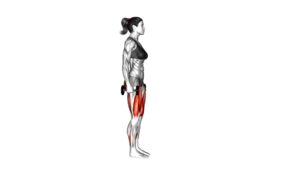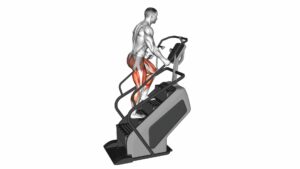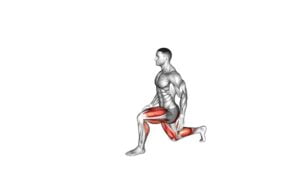Dumbbell Walking Lunges – Video Exercise Guide & Tips

Are you looking for an effective lower body exercise that will give you maximum results? Look no further than dumbbell walking lunges!
Watch This Exercise Video
This video exercise guide and tips will show you how to perform this exercise correctly to target your glutes, quads, and hamstrings. Get ready to feel the burn as you engage multiple muscle groups and improve your strength and stability.
Grab your dumbbells, follow along, and get ready to lunge your way to a stronger lower body!
Key Takeaways
- Dumbbell Walking Lunges increase leg strength and overall lower body muscular development.
- Proper form and technique are important to prevent injuries and maximize benefits.
- The recommended dumbbell weight should be selected based on current strength level and fitness goals.
- There are various variations and progressions of Dumbbell Walking Lunges that target different muscle groups and add variety to the exercise routine.
Benefits of Dumbbell Walking Lunges
The benefits of performing dumbbell walking lunges include increased leg strength, improved balance, and enhanced overall lower body muscular development. This exercise specifically targets your quadriceps, hamstrings, glutes, and calves, making it a great way to build lower body strength. By adding dumbbells to the exercise, you can further challenge your muscles and increase the resistance, leading to even greater strength gains.
Not only does dumbbell walking lunges help you build leg strength, but it also improves your balance. As you step forward and lunge, you engage your core muscles to stabilize your body. This not only enhances your balance during the exercise but also carries over to other movements and activities in your daily life.
Now, let's talk about how to perform dumbbell walking lunges correctly. Start by standing with your feet hip-width apart, holding a dumbbell in each hand. Take a step forward with one foot, bending both knees to lower your body down into a lunge position. Make sure your front knee stays directly above your ankle, and your back knee is just above the ground. Push off your front foot to stand back up and bring your back foot forward to repeat on the other side. Continue alternating legs as you move forward, taking controlled steps. Remember to keep your chest up, core engaged, and maintain a steady pace throughout the exercise.
Proper Form and Technique
To perform dumbbell walking lunges with proper form and technique, follow these steps:
- Step forward with one foot while bending both knees to lower your body into a lunge position.
- Keep your back straight and chest lifted throughout the movement.
- Maintain a neutral spine and avoid rounding your back.
- Keep your front knee aligned with your ankle and avoid letting it extend past your toes.
- Engage your core muscles to stabilize your body and prevent excessive leaning forward or backward.
- Push through your front heel as you stand back up to the starting position.
- Take small, controlled steps to maintain balance and stability.
When performing dumbbell walking lunges, it's important to be aware of common mistakes and potential injuries. Some common mistakes include:
- Rounding the back, which can put unnecessary strain on the spine.
- Allowing the front knee to collapse inward, which can lead to knee pain or injury.
- Taking too large of steps, which can compromise balance and form.
By focusing on proper form and technique, you can minimize the risk of common injuries and maximize the benefits of this exercise.
Now, let's move on to determining the recommended dumbbell weight for your dumbbell walking lunges.
Recommended Dumbbell Weight
To determine the recommended dumbbell weight for your dumbbell walking lunges, you should consider your current strength level and fitness goals. The ideal dumbbell weight for this exercise is one that challenges you without compromising your form.
If you're a beginner or have relatively low strength, start with lighter dumbbells, such as 5-10 pounds. As you progress and your strength increases, you can gradually increase the weight. On the other hand, if you're already advanced and have good strength, you may need to use heavier dumbbells, such as 15-25 pounds or even more.
Common mistakes when choosing dumbbell weight for dumbbell walking lunges include selecting weights that are too heavy or too light. Using weights that are too heavy can lead to poor form and increase the risk of injury. On the contrary, using weights that are too light may not provide enough resistance to effectively challenge your muscles.
It's important to find the right balance and choose a weight that allows you to perform the exercise with proper form while still feeling challenged. Remember to listen to your body and make adjustments accordingly. By selecting the appropriate dumbbell weight, you can maximize the benefits of dumbbell walking lunges and achieve your fitness goals effectively.
Variations and Progressions
Once you have determined the recommended dumbbell weight for your dumbbell walking lunges, you can explore various variations and progressions to further challenge your muscles and enhance your workout. Here are five advanced modifications that you can incorporate into your routine:
- Overhead Dumbbell Walking Lunges: Hold the dumbbells above your head while performing the walking lunges. This variation engages your shoulders and core muscles in addition to your legs.
- Deficit Dumbbell Walking Lunges: Stand on a step or platform, allowing your front foot to step off the edge. This increases the range of motion and targets your glutes and hamstrings.
- Dumbbell Walking Lunges with Knee Drive: As you step forward, drive your back knee up towards your chest. This adds an extra element of balance and stability, while targeting your hip flexors.
- Curtsy Dumbbell Walking Lunges: Instead of stepping forward, cross your back foot behind your front foot in a curtsy-like motion. This variation targets your inner and outer thighs.
- Dumbbell Walking Lunges with Bicep Curls: Hold the dumbbells in each hand and perform a bicep curl with each step. This adds an upper body component to your lunges, targeting your biceps and forearms.
By incorporating these progression variations and advanced modifications into your dumbbell walking lunges, you can keep your workouts challenging and continue to see improvements in your strength and muscle development.
Remember to always use proper form and listen to your body to prevent injury.
Tips for Maximizing Results
To maximize your results, focus on incorporating these key tips into your dumbbell walking lunges routine.
First and foremost, it's important to maximize the intensity of your workout. This can be achieved by increasing the weight of the dumbbells you use or by increasing the number of repetitions or sets you perform. By challenging yourself with heavier weights or more reps, you'll stimulate greater muscle growth and strength gains.
Another tip for maximizing results is to ensure proper form and technique. Common mistakes include not fully extending your legs during the lunge, allowing your knee to extend beyond your toes, or leaning too far forward. These errors can put unnecessary strain on your joints and limit the effectiveness of the exercise. Focus on maintaining a straight back, engaging your core, and keeping your chest lifted throughout the movement.
Additionally, incorporating variations and progressions into your routine can help maximize your results. This can include adding in different types of lunges, such as reverse lunges or side lunges, or increasing the difficulty by performing the lunges on an unstable surface, such as a balance board or Bosu ball. These variations challenge your muscles in new ways, promoting strength and muscle development.
Frequently Asked Questions
How Many Sets and Reps Should I Do for Dumbbell Walking Lunges?
To determine the number of sets and reps for dumbbell walking lunges, consider your fitness level and goals. Start with 2-3 sets of 10-12 reps per leg. If you're a beginner, start with lighter weights and focus on proper form to avoid injury. As you progress, you can increase the weight and reps. Remember to listen to your body and make suitable modifications if needed.
Proper form tips include keeping your chest up, core engaged, and stepping forward with a long stride.
Can Dumbbell Walking Lunges Help With Weight Loss?
Dumbbell walking lunges can definitely help with weight loss. By incorporating this exercise into your routine, you can burn calories and build lean muscle at the same time.
Walking lunges engage multiple muscle groups, increasing your heart rate and boosting your metabolism. To perform them properly, hold a dumbbell in each hand, step forward with one foot, and lower your body until both knees are bent at a 90-degree angle.
Repeat on the other side for maximum results.
Are Dumbbell Walking Lunges Suitable for Beginners?
Dumbbell walking lunges can be a great exercise for beginners. They help improve your leg strength and stability while also engaging your core muscles. To ensure proper form, start by holding the dumbbells at your sides, take a step forward, and lower your body into a lunge position. Make sure to keep your front knee aligned with your ankle and your back knee just above the ground.
Incorporating dumbbell walking lunges into your workout routine can provide numerous benefits for your overall fitness.
Can Dumbbell Walking Lunges Be Performed Without Weights?
Yes, dumbbell walking lunges can be performed without weights. Without weights, you can still enjoy the benefits of this exercise. Dumbbell walking lunges help strengthen your leg muscles, improve balance, and increase your overall lower body strength.
If you don't have dumbbells, you can try alternatives such as bodyweight lunges or using resistance bands. These exercises will still target your leg muscles and provide a challenging workout.
Are There Any Modifications for Individuals With Knee or Hip Issues?
If you have knee or hip issues, there are modifications you can make to the dumbbell walking lunges exercise. Instead of using weights, you can focus on perfecting your form and range of motion. This will help improve your overall strength and stability.
Conclusion
In conclusion, dumbbell walking lunges are a highly effective exercise for strengthening and toning the lower body muscles.
By using proper form and technique, along with the recommended dumbbell weight, you can maximize your results and see improvements in your leg strength and stability.
Additionally, incorporating variations and progressions into your routine can add challenge and variety to your workouts.
So grab those dumbbells and start lunging your way to stronger legs!

Author
Years ago, the spark of my life’s passion ignited in my mind the moment I stepped into the local gym for the first time. The inaugural bead of perspiration, the initial endeavor, the very first surge of endorphins, and a sense of pride that washed over me post-workout marked the beginning of my deep-seated interest in strength sports, fitness, and sports nutrition. This very curiosity blossomed rapidly into a profound fascination, propelling me to earn a Master’s degree in Physical Education from the Academy of Physical Education in Krakow, followed by a Sports Manager diploma from the Jagiellonian University. My journey of growth led me to gain more specialized qualifications, such as being a certified personal trainer with a focus on sports dietetics, a lifeguard, and an instructor for wellness and corrective gymnastics. Theoretical knowledge paired seamlessly with practical experience, reinforcing my belief that the transformation of individuals under my guidance was also a reflection of my personal growth. This belief holds true even today. Each day, I strive to push the boundaries and explore new realms. These realms gently elevate me to greater heights. The unique combination of passion for my field and the continuous quest for growth fuels my drive to break new ground.







